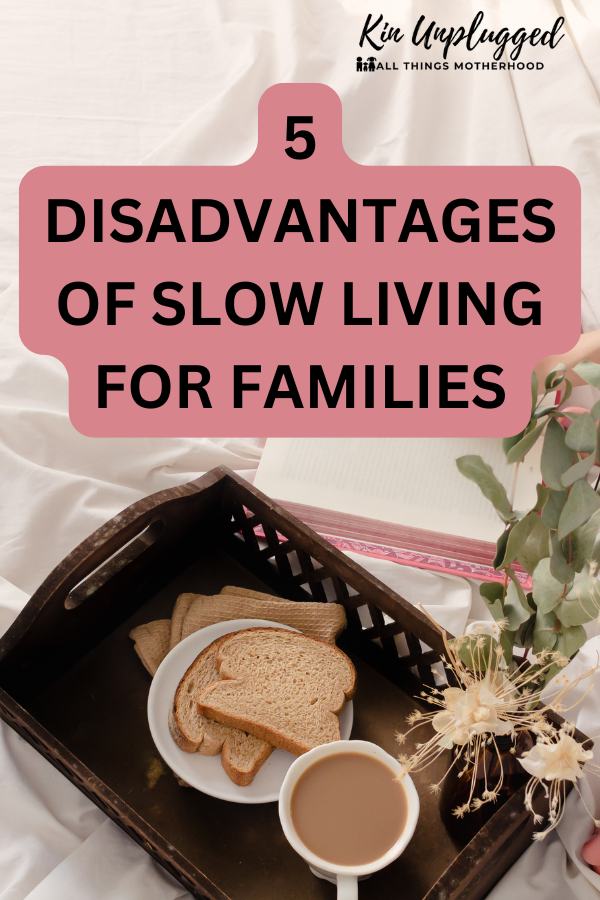Motherhood living is not for the weak. However, we’re all weak in some ways and that’s why all moms can relate to each other’s weaknesses. If you’ve tried to achieve slow living, I understand why you might think that it’s something that is out of reach. Particularly if you have little kids.
It will take great intention but it is possible to an extent at least. In this article, I’ll be sharing the seven tips to help live slow as a mom.
RELATED: 10 Easiest Steps to Lagom living as a family
Let’s start with what exactly slow living is.

What is the slow living approach to parenting?
The slow living approach to parenthood (often called “slow parenting”) emphasizes allowing children to experience life at a natural, unhurried pace. Instead of filling each day with structured activities and fast-paced schedules, slow parenting encourages giving children the space and time to explore, play and learn organically. This approach focuses on nurturing curiosity and letting kids discover the world on their own terms, rather than pushing them to meet milestones or achievements by specific ages.
In practice, slow parenting might look like allowing more unstructured playtime, spending time outdoors and creating a family environment that values presence and mindfulness over busyness. It’s about deeper connections, simpler routines and creating a pace of life that allows both parents and children to truly savor each moment. This way, children can develop a sense of wonder, resilience and self-understanding that isn’t rushed or forced but rather unfolds naturally.
What are the disadvantages to slow parenting?

While slow parenting and the slow live approach encourage children to explore life at a relaxed pace, allowing for more unstructured play and discovery, it does come with potential downsides.
Here are some of the disadvantages that families might encounter with this lifestyle:
- Limited exposure to structure and deadlines. Since “slow live” parenting focuses on a more relaxed schedule, children may miss out on learning to handle structured environments and deadlines. In traditional schooling or future workplaces, they may find it challenging to adjust to schedules that require punctuality, time management and following specific routines.
- Reduced opportunities for skill development. With slow parenting, children may not be enrolled in as many extracurricular activities like sports, music lessons or academic clubs. While this allows them more free time, it could also mean fewer chances to develop specific talents, build teamwork skills or explore interests that require commitment and structure.
- Social limitations. “Slow live” parenting often places emphasis on the family’s own rhythm, which may sometimes isolate children from peers who are involved in more structured or group activities. This could lead to fewer social interactions with other children, limiting their ability to develop social skills in group settings, handle competitive situations or simply enjoy the camaraderie of shared activities.
- Increased parental demands. For parents, the “slow live” approach can require a significant time commitment. Parents are often more hands-on, guiding their children’s exploration and filling their time with enriching, child-centered experiences rather than relying on organized activities or childcare. This can be difficult to manage especially for parents who also work full-time, leaving them with less time for their own pursuits or needs.
- Potential for over-reliance on family. In a slow parenting model, children may become more dependent on their parents for social interaction, play and learning activities. This strong family bond is great, lf course, but it could also make it harder for children to transition to school settings or social gatherings where parents are not present, as they may rely more heavily on family for guidance and support.
The slow live approach offers meaningful benefits but it’s worth balancing that kind of lifestyle with opportunities for social interaction, structured learning and independence-building experiences.
How to slow down when you’re a mom

Slowing down as a mom (especially when you have little kids and a busy schedule) can feel nearly impossible. Yet finding ways to bring more calm into your days can help you enjoy motherhood, strengthen your connection with your children and create a more balanced home. Here’s how to create a slower, more intentional approach to motherhood living even when the to-do list is long:
1. Redefine your priorities and let go of perfection
With little kids, time and energy are limited, and some days, things simply won’t go as planned. Try to focus on the essentials that truly need to get done each day and let go of the rest. It’s perfectly fine if the house isn’t spotless or if dinner is something simple. By easing up on perfection, you can create space for meaningful moments with your kids without feeling pressured to meet every expectation.
2. Slow down essential routines
Daily routines like getting ready in the morning or winding down at night can feel rushed, especially with young children who may resist structure. Simplify where possible: try laying out clothes and packing lunches the night before to make mornings less chaotic. For bedtime, focus on calming activities like reading or a quiet chat, rather than packing in too many tasks. Small changes in your routines can make each part of the day feel more relaxed, helping both you and your kids move through it at a slower pace.
3. Embrace mindful moments throughout the day
With little ones, it’s easy to get caught up in the whirlwind of tasks, but small, mindful moments can help you slow down. Whether you’re washing dishes, folding laundry, or making a snack, try to focus solely on that activity. Instead of rushing through tasks while multitasking, immerse yourself in the present moment. Not only will this help you slow down, but it also models mindfulness for your kids, who are learning how to engage with the world at their own pace.
4. Prioritize quality time over quantity of activities
As a mom, there’s often pressure to keep your kids busy and involved in numerous activities. However, slowing down means focusing on a few meaningful experiences. Choose activities that bring real joy and connection, like reading a favorite book together, enjoying a walk, or simply sitting down to chat. You don’t have to fill every minute of the day with scheduled events to create special memories.
5. Set boundaries around commitments and say ‘no’ when needed
It can be hard to say no, especially when other parents seem to have their kids involved in everything. However, committing to too many activities can quickly leave you feeling overwhelmed and rushed. By setting clear boundaries and saying no to unnecessary commitments, you create space to slow down. Prioritize what truly aligns with your values and needs, and let go of the pressure to keep up with every invitation or activity.
6. Teach your children to appreciate unhurried time
Modeling at a slower pace can help your kids learn to appreciate unhurried moments. Instead of rushing from one activity to the next, show them the beauty of slowing down. Encourage them to enjoy free play, let them explore their creativity, and allow time for quiet moments. These lessons will help them grow up knowing that not everything has to be done quickly, and that sometimes the best memories are made in the simplest, slowest moments.
7. Create space for your own self-care
Slowing down isn’t just about taking things easier with your kids; it’s also about carving out time for yourself. It’s hard to be present and mindful when you’re constantly running on empty. Whether it’s taking a quiet walk, reading a book, or simply enjoying a hot cup of coffee, find ways to replenish your own energy. Prioritizing self-care helps you maintain the patience and mental clarity needed to slow down in your daily life.
Having read that, which of those tips do you intend to implement? Do you think slow living is achievable for you?






